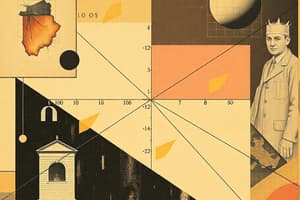Podcast
Questions and Answers
What is the initial step in analyzing an engineering system?
What is the initial step in analyzing an engineering system?
- Analyzing external elements that interact with the system.
- Defining the main useful function the system is designed to achieve. (correct)
- Understanding the interactions between system elements.
- Identifying all the components of the system.
Which of the following best describes the relationship between a person waiting for a bus and the bus itself, according to the content?
Which of the following best describes the relationship between a person waiting for a bus and the bus itself, according to the content?
- There is a potential interactive function when the bus arrives and the person boards.
- There is a direct functional relationship, as the bus is meant to transport the person.
- There is an indirect function, as the bus company provides a service to the person.
- There are no functions because there are no interactions when the person is waiting. (correct)
In function analysis, which of the following describes the action of a cup in relation to coffee?
In function analysis, which of the following describes the action of a cup in relation to coffee?
- Cup warms coffee
- Cup cools coffee
- Cup holds coffee (correct)
- Cup contains coffee
What is the relationship between components within the context of an engineering system?
What is the relationship between components within the context of an engineering system?
Which of the following describes system components?
Which of the following describes system components?
What is the primary focus of function analysis in the context of engineering systems?
What is the primary focus of function analysis in the context of engineering systems?
In function analysis, what best describes the 'object' in the function?
In function analysis, what best describes the 'object' in the function?
Why is it important to use simple language in function models according to the content?
Why is it important to use simple language in function models according to the content?
What does the 'main useful function' of an engineering system primarily deliver?
What does the 'main useful function' of an engineering system primarily deliver?
Which of the following describes the relationship between solutions and functions?
Which of the following describes the relationship between solutions and functions?
Flashcards
Main Useful Function
Main Useful Function
The primary purpose that an object is designed to achieve.
Function Analysis
Function Analysis
The process of identifying and evaluating an object's main useful functions and roles.
Components of Engineering System
Components of Engineering System
Interrelated and interdependent parts that together accomplish the main function.
Interaction in Systems
Interaction in Systems
Signup and view all the flashcards
Engineering System Purpose
Engineering System Purpose
Signup and view all the flashcards
Function Model
Function Model
Signup and view all the flashcards
Function Language
Function Language
Signup and view all the flashcards
Main Function
Main Function
Signup and view all the flashcards
Subject and Object
Subject and Object
Signup and view all the flashcards
Study Notes
Function Analysis & Trimming
- Course: Systematic Innovation and Innovative Problem Solving
- Semester: 1, 2022/2023
- Course Code: TMS/N/T1003
Learning Objectives
- Students should be able to describe function analysis.
- Students should be able to illustrate component analysis, interaction analysis, and function model processes.
- Students should be able to demonstrate the trimming process.
Functionality
- Customers buy functions, not products.
- Understanding basic functions is key to successful TRIZ application.
- Solutions change, but functions remain the same.
- Function-based knowledge organization allows access to other solutions.
Function Analysis
- Component Analysis: Identifies components of the engineering system and its supersystem.
- Interaction Analysis: Identifies interactions between components.
- Function Model: Identifies and evaluates the functions performed by components.
Function Analysis (Continued)
- Subject: The carrier of the function (action-verb).
- Object: The recipient of the subject's action, with parameters that are changed or maintained due to the action.
- Subject and object are components interacting with the system or supersystem.
- Functions are actions performed between the subject and object.
- Parameters describe an inherent property of components.
Function Language
- Simple language is used to describe functions easily understandable by children.
- Examples: Table holds book; Table holds dog; Bristle removes food; String removes food; Stick removes food.
Avoid Technical Jargon
- Technical language can restrict potential solutions, while function language widens the scope of potential solutions.
- Examples of technical language/function language translation: Etch/Remove; Distill/Separate; Encapsulate/Include; Stream/Deliver; Zip/Reduce.
Main Function
- The engineering system's primary purpose is producing a product.
- A product fulfils consumers' needs and aims.
- Most engineering systems have one product.
Main Useful Function
- Identifying the function of a system is the first step in analyzing it.
- Identify what a system is meant to do or achieve.
- Examples provided include chair - holds person and Car - moves driver.
- Table holds bottle; Bottle holds liquid; Cap seals bottle.
Interaction Analysis
- An analytical tool used to understand the relationship between components of an engineering system.
- This identifies and understands how components in the engineering system interact with each other.
Function Model
- Examines the interaction between components in a system.
- Identifies strengths and weaknesses of functions acting on components.
- Identifies advantageous and disadvantageous functions impacting various components.
Function Model (Continued)
- Aims to identify harmful, insufficient, and excessive functions performed by an object.
- Classifies functions based on whether they are useful (normal, insufficient, or excessive) or harmful.
- Examples illustrated through a refrigerator and a gas stove.
Definition of Interactions - Useful Functions
- A useful function provides the designed purpose/requirement to its users.
- Normal: The actual value equals the required value.
- Insufficient: The actual value falls below the required value.
- Excessive: The actual value exceeds the required value.
Definition of Interactions - Harmful Functions
- A harmful function worsens the object's parameters.
- Harmful: Actual value generates damaging or undesirable effects on objects.
- Examples of harmful and useful functions include those related to a robotic arm interacting with a plastic bottle.
Examples (Systems and Their Functions)
- Refrigerators cool food
- Useful: Cools food from the back; Normal temperature cooling;
- Harmful: Noise; CFCs;
- Excessive: Excessive cooling;
- Insufficient: Insufficient cooling.
- Gas stoves heat objects
- Automobiles move people.
- Computers process information.
- Telephones transmit audio signals.
Exercise - Trimming Case Studies
- Several examples of trimming case studies are presented for different items including toothbrushes, skipping ropes, and more.
- Steps include identifying components, understanding interactions, building function models for trimming.
- Trimming rules include: removing functions no longer needed by the object, performing functions through the object itself, and transferring functions to another component or supersystem.
Trimming
- A method for reducing engineering system components.
- Aims to reduce unwanted functions.
- Aims to reduce costs and increase efficiency.
Trimming Rules
- Rule A: Eliminates functions if the object no longer exists.
- Rule B: If the object being worked by a function also performs the function itself–eliminate one function (the subject).
- Rule C: Transfers a function to another component.
Trimming Factor
- A product diagnostic analysis framework.
- Considers the interaction between functions and their problems/costs.
- Identifies and ranks best candidates for reducing problems and costs.
Studying That Suits You
Use AI to generate personalized quizzes and flashcards to suit your learning preferences.




